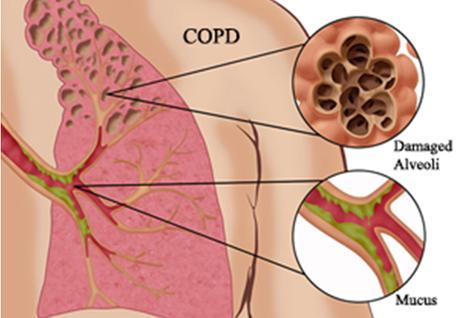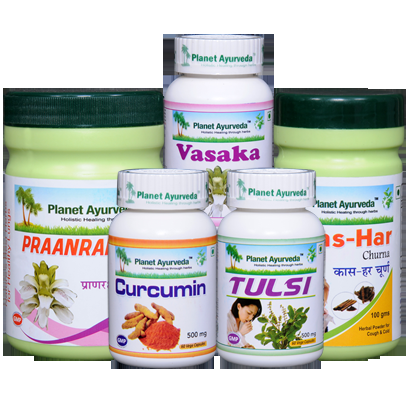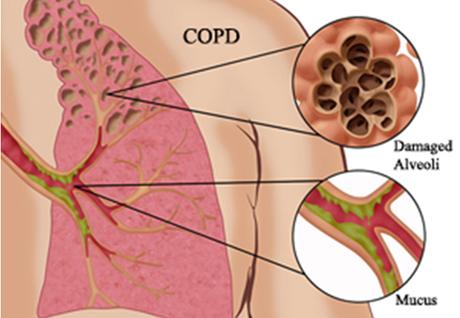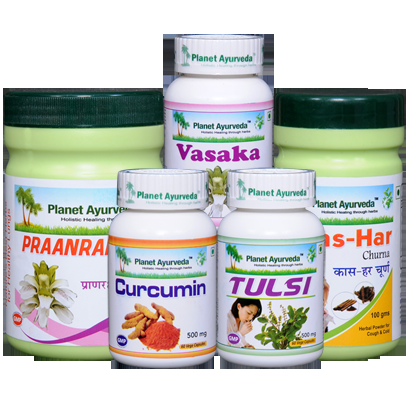introduction
COPD is a chronic inflammatory disease that can cause obstructed airflow from the lungs. Chronic Obstructive Pulmonary Disease is commonly referred to as a group of lung diseases. The most common are emphysema and bronchitis. It is a progressive disease which means the disease gets worse over time. COPD is generally characterized by increased breathlessness. It is caused by prolonged exposure to certain gases and particles. The main symptoms include breathing difficulty, cough and wheezing (whistling sound). Emphysema is a condition in which the alveoli at the end of air passages are damaged due to continuous exposure to cigarette smoking or certain gases. Bronchitis is the inflammation of bronchioles. Bronchioles are the airways that carry oxygen to the lungs. It causes breathlessness, cough and chest tightness.
COPD is more common in females (56%) than in males (44%). (REF. COPD NATIONAL ACTION PLAN)

definition
COPD is lung disease which is characterized by chronic inflammation of airflow that interferes with normal breathing and is not fully reversible. Emphysema and bronchitis are included under COPD.
AYURVEDA ASPECT OF COPD
(Reference: Charak Chiktsa Sathan)
In Ayurveda, COPD is considered under shwaas rog (श्वास रोग).COPD is a disease of pranavaha srotas. When there is an increase in kapha (mainly kapha) and vata in the body, it spreads throughout the body and causes COPD.
In Ayurveda there are five types of shwaas:
- Mahashwaas (Vata dosh)
- Urdhvashwaas (Vata)
- Tamak Shwaas(Kapha Vata)
- Partamak Shwaas (Kapha)
- Shudra shwaas (Vata)
TYPES- Following diseases are included under COPD
- Emphysema
- Bronchitis
It is a chronic disease that is not communicable and affects the lungs.
Males who smoke are more prone to this disease. It can occur to any age group.
SPIROMETRY AND STAGES OF COPD-
FVC (FORCED VITAL CAPACITY)-This is the largest amount of air you can breathe out after breathing in as deeply as you can.
FVC (FORCED VITAL CAPACITY)-This is the largest amount of air you can breathe out after breathing in as deeply as you can.
STAGES OF COPD
COPD is categorized under following categories
- Mild
- Moderate
- Severe
- Very Severe
1. Mild (STAGE 1) -There may be no symptoms or shortness of breath during brisk walking or climbing a hill or climbing stairs. .
2. MODERATE (STAGE2)-In this stage if you are walking on level ground, you have to stop every few minutes to catch your breath.
3. SEVERE (STAGE-3)-In this stage there is shortness of breath even doing little things like dressing and undressing.
4. VERY SEVERE (STAGE 4)-There is difficulty in breathing even during rest along with chest tightness.
MAIN CAUSES OF COPD
- Tobacco smoking- The main cause of COPD is tobacco smoking.
- Secondhand smoke-Even if you are not a smoker you can get COPD if you are living with a smoker.
- Asthma- If you have asthma and you are not taking any treatment, it can lead to COPD..
- Pollution-You can get COPD if you have continued exposure to harmful gases and toxic substances.
SYMPTOMS OF THE DISEASE
- Shortness of breath especially during physical activity
- Wheezing
- Chest tightness
- A chronic cough can lead to mucus which may be white, yellow, or greenish
- Frequent respiratory infections
SEVERE SYMPTOMS
- Swelling at extremities
- Bluish discoloration of the skin (cyanosis)
- Rapid breathing
- Acute chest discomfort
- Diffuse breath sounds
MAIN RISK FACTORS
People who smoke tobacco are at the highest risk of COPD. Other risk factors include secondhand smoke (you are not a smoker but you are living with a smoker), exposure to toxic substances and gases. There is a genetic factor called alpha-1 antitrypsin that places a small percentage(1%) of people at higher risk for COPD because a protective factor ( alpha 1 antitrypsin)for lung elasticity is decreased or almost absent.
Other factors which may lead to COPD are mentioned
- Connective tissue disorders
- Immune deficiencies disorders
- Vasculitis syndromes
DIAGNOSIS OF THE DISEASE
The preliminary criteria to diagnose COPD in an affected person is given below
- By brief history
- By breathing history
- By history of tobacco smoking
- By history of exposure to chemicals and toxic gases
LAB INVESTIGATIONS TO DIAGNOSE COPD
Pulmonary function test
PFT tests can detect the problem even before appearing the symptoms. This includes the spirometry test and lung volume tests.
Sputum examination
A sputum sample is taken to check the disease. The presence of bacteria in the sample confirms the COPD.
- Pulse oximetry- the amount of oxygen in the blood is measured with the help of a small device that is attached to your fingertips.
- Chest x-rays
- CT scan of lungs (computerized tomography)
- Arterial blood gas (abgs) or pulse oximeter to look for oxygen saturation rate in the patient's blood.
COPD TREATMENT IN AYURVEDA



According to Ayurveda COPD treatment includes:
1. Nidan Parivarjan
- Nidan Parivarjan is to avoid the known disease-causing factors in the diet and lifestyle of the patient.
- Avoid tobacco smoking
- Avoid exposure to pollution, chemical substances, and toxic gases.
- Avoid second-hand smoke (living with people who smokes)
2. Shodhan Chikitsa
- Shodhan Chikitsa means the elimination of toxins from the body by performing panchakarma. According to ayurveda COPD occurs due to an increase of vata and kapha in the body (as there are three doshas in body which include vata, pitta, and kapha and imbalance in these three doshas lead to diseases).
- Sweden (Steaming)-Rock salt and sesame oil steam are used to pacify kapha dosha.
- Snehan-after snehan, medicated ghee is given to the patient. Snehan is given to initiate Vamana karma (emesis) in patients. Virechana is given in Tamak shwas.
- Doompan (Ayurveda herbal smoking)-to completely remove excess kapha dosha in body herbal smoking is given to the patient.
3. Shaman Chikitsa
Shaman Chikitsa includes the removal of toxins by consuming oral medicines.
BEST HERBS USED IN COPD
- Curcumin (Curcuma longa) - Curcumin has anti-inflammatory and antioxidant properties
- Tulsi (Ocimum sanctum)-It is anti-inflammatory.
- Shunthi (Zingiber officinale)-It breaks down mucus, increases circulation in the lungs. It is anti-inflammatory.
PRODUCTS OF PLANET AYURVEDA
- Curcumin capsules- 2 capsules daily twice with water after meals.
- Tulsi capsules-1 capsules daily twice with water after meals.
- Praanrakshak churna- 1 teaspoon twice daily with water or honey after meals.
- Kaas-har churna-1 teaspoon twice daily with water or honey after meals.
- Vasaka capsules-2 capsules daily twice with water after meals.
DIET AND LIFESTYLE
Dietary habits play a huge role in the treatment of COPD. It is very important in COPD to follow a healthy diet.
FOOD TO AVOID
- Curd
- Cheese
- Buttermilk
- Ice cream
- All fried foods
- Carbonated soft drinks
- Citrus fruits
FOOD TO TAKE
- Potassium-rich foods like avocado, dark leafy vegetables, potato, tomato, banana, oranges.
- Peas, beans, oats.
Yoga -Yoga is very beneficial for COPD patients. Following yoga asanas can help in the improvement of COPD.
- Standing mountain pose
- Standing backbend
- Pranayama
References
https://www.nhlbi.nih.gov/sites/default/files/media/docs/COPD%20national%20action%20plan%20508_0.pdfDR. Vikram Chauhan, MD - AYURVEDA is an expert ayurvedic doctor based in Chandigarh, India and doing his practice in Mohali, India. He is spreading the knowledge of Ayurveda - Ancient healing treatment, not only in India but also abroad. He is the CEO and Founder of Planet Ayurveda Products, Planet Ayurveda Clinic and Krishna Herbal Company. Write at - [email protected], Contact at - +91-172-521-4030 Websites - www.planetayurveda.com, www.alwaysayurveda.com
View more posts from this authorintroduction
COPD is a chronic inflammatory disease that can cause obstructed airflow from the lungs. Chronic Obstructive Pulmonary Disease is commonly referred to as a group of lung diseases. The most common are emphysema and bronchitis. It is a progressive disease which means the disease gets worse over time. COPD is generally characterized by increased breathlessness. It is caused by prolonged exposure to certain gases and particles. The main symptoms include breathing difficulty, cough and wheezing (whistling sound). Emphysema is a condition in which the alveoli at the end of air passages are damaged due to continuous exposure to cigarette smoking or certain gases. Bronchitis is the inflammation of bronchioles. Bronchioles are the airways that carry oxygen to the lungs. It causes breathlessness, cough and chest tightness.
COPD is more common in females (56%) than in males (44%). (REF. COPD NATIONAL ACTION PLAN)

definition
COPD is lung disease which is characterized by chronic inflammation of airflow that interferes with normal breathing and is not fully reversible. Emphysema and bronchitis are included under COPD.
AYURVEDA ASPECT OF COPD
(Reference: Charak Chiktsa Sathan)
In Ayurveda, COPD is considered under shwaas rog (श्वास रोग).COPD is a disease of pranavaha srotas. When there is an increase in kapha (mainly kapha) and vata in the body, it spreads throughout the body and causes COPD.
In Ayurveda there are five types of shwaas:
- Mahashwaas (Vata dosh)
- Urdhvashwaas (Vata)
- Tamak Shwaas(Kapha Vata)
- Partamak Shwaas (Kapha)
- Shudra shwaas (Vata)
TYPES- Following diseases are included under COPD
It is a chronic disease that is not communicable and affects the lungs.
Males who smoke are more prone to this disease. It can occur to any age group.
SPIROMETRY AND STAGES OF COPD-
FVC (FORCED VITAL CAPACITY)-This is the largest amount of air you can breathe out after breathing in as deeply as you can.
FVC (FORCED VITAL CAPACITY)-This is the largest amount of air you can breathe out after breathing in as deeply as you can.
STAGES OF COPD
COPD is categorized under following categories
1. Mild (STAGE 1) -There may be no symptoms or shortness of breath during brisk walking or climbing a hill or climbing stairs. .
2. MODERATE (STAGE2)-In this stage if you are walking on level ground, you have to stop every few minutes to catch your breath.
3. SEVERE (STAGE-3)-In this stage there is shortness of breath even doing little things like dressing and undressing.
4. VERY SEVERE (STAGE 4)-There is difficulty in breathing even during rest along with chest tightness.
MAIN CAUSES OF COPD
- Tobacco smoking- The main cause of COPD is tobacco smoking.
- Secondhand smoke-Even if you are not a smoker you can get COPD if you are living with a smoker.
- Asthma- If you have asthma and you are not taking any treatment, it can lead to COPD..
- Pollution-You can get COPD if you have continued exposure to harmful gases and toxic substances.
SYMPTOMS OF THE DISEASE
- Shortness of breath especially during physical activity
- Wheezing
- Chest tightness
- A chronic cough can lead to mucus which may be white, yellow, or greenish
- Frequent respiratory infections
SEVERE SYMPTOMS
- Swelling at extremities
- Bluish discoloration of the skin (cyanosis)
- Rapid breathing
- Acute chest discomfort
- Diffuse breath sounds
MAIN RISK FACTORS
People who smoke tobacco are at the highest risk of COPD. Other risk factors include secondhand smoke (you are not a smoker but you are living with a smoker), exposure to toxic substances and gases. There is a genetic factor called alpha-1 antitrypsin that places a small percentage(1%) of people at higher risk for COPD because a protective factor ( alpha 1 antitrypsin)for lung elasticity is decreased or almost absent.
Other factors which may lead to COPD are mentioned
- Connective tissue disorders
- Immune deficiencies disorders
- Vasculitis syndromes
DIAGNOSIS OF THE DISEASE
The preliminary criteria to diagnose COPD in an affected person is given below
- By brief history
- By breathing history
- By history of tobacco smoking
- By history of exposure to chemicals and toxic gases
LAB INVESTIGATIONS TO DIAGNOSE COPD
Pulmonary function test
PFT tests can detect the problem even before appearing the symptoms. This includes the spirometry test and lung volume tests.
Sputum examination
A sputum sample is taken to check the disease. The presence of bacteria in the sample confirms the COPD.
- Pulse oximetry- the amount of oxygen in the blood is measured with the help of a small device that is attached to your fingertips.
- Chest x-rays
- CT scan of lungs (computerized tomography)
- Arterial blood gas (abgs) or pulse oximeter to look for oxygen saturation rate in the patient's blood.
COPD TREATMENT IN AYURVEDA



According to Ayurveda COPD treatment includes:
1. Nidan Parivarjan
- Nidan Parivarjan is to avoid the known disease-causing factors in the diet and lifestyle of the patient.
- Avoid tobacco smoking
- Avoid exposure to pollution, chemical substances, and toxic gases.
- Avoid second-hand smoke (living with people who smokes)
2. Shodhan Chikitsa
- Shodhan Chikitsa means the elimination of toxins from the body by performing panchakarma. According to ayurveda COPD occurs due to an increase of vata and kapha in the body (as there are three doshas in body which include vata, pitta, and kapha and imbalance in these three doshas lead to diseases).
- Sweden (Steaming)-Rock salt and sesame oil steam are used to pacify kapha dosha.
- Snehan-after snehan, medicated ghee is given to the patient. Snehan is given to initiate Vamana karma (emesis) in patients. Virechana is given in Tamak shwas.
- Doompan (Ayurveda herbal smoking)-to completely remove excess kapha dosha in body herbal smoking is given to the patient.
3. Shaman Chikitsa
Shaman Chikitsa includes the removal of toxins by consuming oral medicines.
BEST HERBS USED IN COPD
- Curcumin (Curcuma longa) - Curcumin has anti-inflammatory and antioxidant properties
- Tulsi (Ocimum sanctum)-It is anti-inflammatory.
- Shunthi (Zingiber officinale)-It breaks down mucus, increases circulation in the lungs. It is anti-inflammatory.
PRODUCTS OF PLANET AYURVEDA
- Curcumin capsules- 2 capsules daily twice with water after meals.
- Tulsi capsules-1 capsules daily twice with water after meals.
- Praanrakshak churna- 1 teaspoon twice daily with water or honey after meals.
- Kaas-har churna-1 teaspoon twice daily with water or honey after meals.
- Vasaka capsules-2 capsules daily twice with water after meals.
DIET AND LIFESTYLE
Dietary habits play a huge role in the treatment of COPD. It is very important in COPD to follow a healthy diet.
FOOD TO AVOID
FOOD TO TAKE
- Potassium-rich foods like avocado, dark leafy vegetables, potato, tomato, banana, oranges.
- Peas, beans, oats.
Yoga -Yoga is very beneficial for COPD patients. Following yoga asanas can help in the improvement of COPD.
- Standing mountain pose
- Standing backbend
- Pranayama

